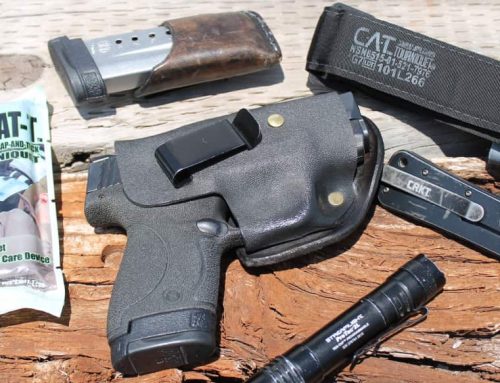How to Defend Yourself In 5 Potentially Dangerous Situations, According to Experts
It really sucks that you even need to consider these techniques — but because assaults will never stop entirely, they’re important to know.
For most female entrepreneurs, launching a product –– the cumulation of months (maybe years) of blood, sweat, and tears –– is an exhilarating moment. But for Quinn Fitzgerald and Sara Dickhaus de Zarraga, that sentiment was decidedly different when their product, Flare, went to market.
“It’s terrible that this product has to exist,” says Dickhaus de Zarraga. “We hate that we’re at this point.”
Flare, created by the duo, both Harvard Business School grads, in 2016, is a discreet “bracelet” (Buy It, $129, getflare.com) designed to help people exit unsafe or uncomfortable situations. The wearer presses a hidden button on the bracelet’s interior, alerting a list of pre-chosen contacts (or the police) of their location. The bracelet can also send out a fake phone call to the wearer’s phone for a quick excuse to exit an iffy situation. (All of this can be configured in their app.)
The pair, who are both victims of sexual assault, say they created Flare because most self-defense devices at the time were made by men. “In the past, the only tools to protect yourself were a whistle or personal alarm to make noise, pepper spray, a weapon to harm the other person, or a call for help,” explains Dickhaus de Zarraga. “And, depending on your identity, or if you are a person of color, [those options] can put you in more danger.”
Throughout history, the onus has been on womxn to prevent sexual assault — whether that means forgoing alcohol (or parties entirely), avoiding clothing styles that may be deemed provocative (despite Sarah Everard donning sweatpants when she was abducted in the U.K.), and doing whatever is necessary to avoid any kind of attention — rather than make larger changes in society to prevent the violent actions of the perpetrators themselves. (
Of course, saying that we live in an empowered world where womxn don’t need to buy sneaky bracelets, learn crazy martial arts moves, or constantly be stressing about their environments 24/7 is like professing that we live in a post-racial society. Roughly 8 in 10 U.S.women over the age of 18reported being sexually assaulted in one 2018 survey, while a more recent study of U.K. women found that the number there could be closer to 97 percent. (And while you might think the study’s small sample size doesn’t tell a big enough picture, one scan of the hashtag #97perecent on TikTok, which directly references the study’s finding, provides ample proof that womxn are encountering sexual assault at seriously alarming rates.) Hell, even just existing at work as a Black woman can be cause for predation. In fact, Black women report experiencing sexual harassment at work at three times the rate of white women, according to a report by the National Women’s Law Center, a nonprofit legal rights organization.
The fact that womxn need to shield themselves from uncomfortable (or even dangerous) situations — specifically, with men — sucks. But the truth is, as a report from the World Health Organization reveals, the vast majority of violence against women is perpetrated by men. In fact, the study notes that there wasn’t even enough data to observe same-sex violence against women. What’s more, violence against trans or gender-non-conforming women skyrocketed in 2020, with 44 fatalities in the U.S. — making it the deadliest year on record, according to the Human Rights Campaign.
That being said, while fear of attacks shouldn’t necessarily prevent you from living your life, taking a few necessary precautions and arming yourself with self-defense knowledge can help you feel more at ease.
Here, experts walk through how to handle five potentially dangerous situations you might find yourself in, and how to safely get out fast.
You’re Walking Through a Dark and/or Sketchy Parking Lot at Night
In places where you’re heading to or from, a destination (such as parking garages and lots) are some of the more common spots for predation, according to Beverly Baker, self-defense expert and founder of Asphalt Anthropology in Los Angeles. “These places require extra diligence, as they’re public enough for someone to access you, but often private enough to allow them to work without witnesses or interference,” explains Baker.
Upon entering a garage or parking lot, Baker always advises her clients to scan the area. Are there pillars, stairwells, or large vehicles a person could hide behind? Avoid those areas, she advises, and try to park as close as possible to the entrance or exit.
“Also, when you arrive, back your car into the spot,” she advises. “This means you don’t have to walk the full length of the car to get to the driver’s door and you can pull out with full visibility of your surroundings.”
Other transition-area tips from Baker? Put your phone down, walk quickly and confidently with your gaze wide, and have your hands free (but keep your keys handy so you can quickly unlock and jump in your vehicle).
Oh, and speaking of those keys –– you should hold them like a dagger between your fingers to attack any on-comers, right? “There is a long-standing myth that holding your keys between your fingers is a good self-defense weapon, but this is not true!” says Baker. “Keys will move on impact and risk harming you more than the threat.”
Instead, Baker recommends carrying and keeping some type of self-defense weapon close by — although it’s highly dependent on your comfort level and what is legal in your area. This might include pepper spray or some kind of stun gun , a knife, a high-beam flashlight to temporarily distract an attacker, or even a heavy object in your path, like a heavy candle, items on a bookshelf, or scissors. (
You’re Being Followed, Either On Foot or In Your Car
If there’s anything more intimidating than entering a dark, shadowy parking garage at night, it’s walking or driving alone –– and possibly being pursued.
The first step if you suspect you’re being followed is to simply turn around. “The [other] car would have to do a U-turn or abandon their car,” notes Baker.
If you can, Baker advises walking toward safety rather than simply away from danger. “Don’t turn and walk down an abandoned alley,” she says. “Step into a shop if you can.”
That same logic applies if you suspect a vehicle is trailing you while you’re driving. “Don’t go home if you’re being followed,” says Baker, noting that you should always be heading toward safety where you can flag for help (think: a fire station, police station, shop, or restaurant).
Your Date Is Uncomfortably Pushy
While attackers jumping out of bushes or in parking garages is an obvious scare, some (rather, most) assaults occur in more intimate, familiar ways: i.e. an uncomfortably aggressive Tinder date.
“If you’re in an uncomfortable situation, look for an advocate,” advises Heather Hansen, self-advocacy expert, legal analyst, and trial attorney. Hansen notes that this could be anyone nearby, be it a bartender or fellow patron, that you can let know that you’re in a sticky situation. You should ask the advocate to interject in your date (say, if you have to get up to go to the bathroom) and ask a series of questions: “How’s everyone doing?” or “what are you drinking over here?” suggests Hansen suggests.
“If the perpetrator continues, the bystander can simply ask what you both are doing,” notes Hansen. “This is especially effective if the bystander identifies as male and the perpetrator does as well.” At that point, Hansen stresses, (hopefully) your options have opened up in terms of leaving. While your date is distracted, can you flag down a bartender or someone from security to interject and help get you out? Although you’ll need to assess the situation (every individual will react differently), try to map avenues for an exit as soon as someone enters the scene.
Another option for (discreetly) exiting an uncomfortable situation at a bar or restaurant: order an “angel shot.” As one viral TikTok from creator @benjispears explains, the shot is essentially code for “I’m in trouble; help me.” While not all establishments have one (and it may be called something else in order to protect its secrecy from offenders), you’ll typically see a sign posted in the bathroom alerting womxn that it’s an option. Regardless of whether the place you’re in participates, don’t hesitate to just flag someone down en route to, or inside, the bathroom if you’re unsure.
If there’s no one nearby, or you feel uncomfortable asking around, Hansen recommends telling your pushy date upfront that you’re uncomfortable. And, of course, try not to touch your food or drink if it’s been out of your sight, even for a moment, as someone could have tampered with it.
And if things escalate, don’t be afraid to get up and leave. “Get a ride home from someone else or choose a ride-sharing service,” says Baker, noting that if you’re worried about being followed, you can ask security to escort you to your destination (or have call police to help).
You’re Getting Harassed By Your Boss or Another Superior
When it comes to snide DMs from coworkers or an awkward moment with a high-up VP on a work trip, Hansen stresses one super-important (but simple) rule with workplace harassment: “Document everything –– including every instance of harassment and how you respond. Have absolutely everything in writing if you can.” (She notes that, in some states, it’s illegal to record a conversation without consent from all parties, so keep that in mind.)
Hansen notes that finding an advocate is key, too. “Talk to someone in human resources if the perpetrator is your boss, and talk to your boss if it’s someone in human resources,” she advises.
But what should you do in the moment to protect yourself and diffuse the situation? That’s tricky, says Hansen.”Whether speaking to the harasser or your ally, I would suggest keeping it factual and objective: ‘When you do this/he does this, and it makes me feel this way.'” While being harassed is an extremely emotional experience, if you can work to respond rather than react, you will be a much stronger advocate.”
Of course, if at any time you fear for your safety and are in immediate danger, go directly to the police — again, with proof of harassment, if you have it.
You’re Being Accosted or Followed On Public Transit
Similar to if you’re being followed by a car or on foot, with public transit, you should be heading toward safety rather than away from danger, says Baker. But until that point, simply confronting whoever you suspect is stalking you can help — despite how scary it may seem. “I’ve done this with my heart racing,” admits Baker. “But here’s the thing: Threats don’t want a hard target. Many of them enjoy making you afraid. Flip the script.” Baker says that saying something along the lines of “What do you want?” or, more concretely, “Why are you following me?” can help.
If you’re not comfortable engaging with the person, that’s okay, too. Change train cars, get off, and wait for the next one. “Better to be late than uncomfortable,” says Baker. And at any time where you feel like you’re in serious danger, including any of these instances above, don’t hesitate to call 9-1-1.
Source https://www.shape.com/lifestyle/mind-and-body/self-defense-saftey-tips-for-women






